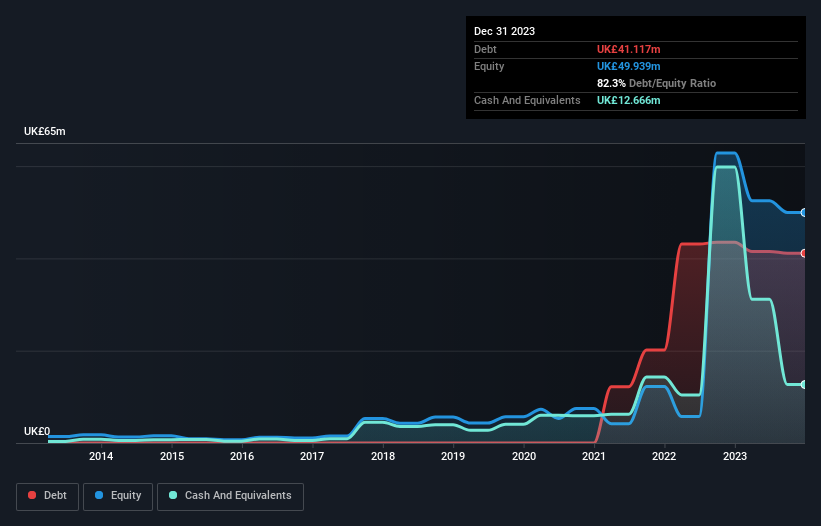Some say volatility, rather than debt, is the best way to think about risk as an investor, but Warren Buffett famously said that ‘Volatility is far from synonymous with risk.’ So it might be obvious that you need to consider debt, when you think about how risky any given stock is, because too much debt can sink a company. We can see that Greatland Gold plc (LON:GGP) does use debt in its business. But the more important question is: how much risk is that debt creating?
Why Does Debt Bring Risk?
Debt assists a business until the business has trouble paying it off, either with new capital or with free cash flow. Ultimately, if the company can’t fulfill its legal obligations to repay debt, shareholders could walk away with nothing. However, a more frequent (but still costly) occurrence is where a company must issue shares at bargain-basement prices, permanently diluting shareholders, just to shore up its balance sheet. By replacing dilution, though, debt can be an extremely good tool for businesses that need capital to invest in growth at high rates of return. The first thing to do when considering how much debt a business uses is to look at its cash and debt together.
See our latest analysis for Greatland Gold
What Is Greatland Gold’s Debt?
You can click the graphic below for the historical numbers, but it shows that Greatland Gold had UK£41.1m of debt in December 2023, down from UK£43.5m, one year before. However, it also had UK£12.7m in cash, and so its net debt is UK£28.5m.

How Strong Is Greatland Gold’s Balance Sheet?
We can see from the most recent balance sheet that Greatland Gold had liabilities of UK£4.60m falling due within a year, and liabilities of UK£43.3m due beyond that. Offsetting these obligations, it had cash of UK£12.7m as well as receivables valued at UK£60.0k due within 12 months. So its liabilities outweigh the sum of its cash and (near-term) receivables by UK£35.2m.
Of course, Greatland Gold has a market capitalization of UK£315.6m, so these liabilities are probably manageable. But there are sufficient liabilities that we would certainly recommend shareholders continue to monitor the balance sheet, going forward. When analysing debt levels, the balance sheet is the obvious place to start. But it is future earnings, more than anything, that will determine Greatland Gold’s ability to maintain a healthy balance sheet going forward. So if you want to see what the professionals think, you might find this free report on analyst profit forecasts to be interesting.
Given its lack of meaningful operating revenue, investors are probably hoping that Greatland Gold finds some valuable resources, before it runs out of money.
Caveat Emptor
Over the last twelve months Greatland Gold produced an earnings before interest and tax (EBIT) loss. To be specific the EBIT loss came in at UK£13m. When we look at that and recall the liabilities on its balance sheet, relative to cash, it seems unwise to us for the company to have any debt. Quite frankly we think the balance sheet is far from match-fit, although it could be improved with time. Another cause for caution is that is bled UK£29m in negative free cash flow over the last twelve months. So suffice it to say we consider the stock very risky. When analysing debt levels, the balance sheet is the obvious place to start. However, not all investment risk resides within the balance sheet – far from it. For example, we’ve discovered 4 warning signs for Greatland Gold (3 are concerning!) that you should be aware of before investing here.
When all is said and done, sometimes its easier to focus on companies that don’t even need debt. Readers can access a list of growth stocks with zero net debt 100% free, right now.
Valuation is complex, but we’re helping make it simple.
Find out whether Greatland Gold is potentially over or undervalued by checking out our comprehensive analysis, which includes fair value estimates, risks and warnings, dividends, insider transactions and financial health.
Have feedback on this article? Concerned about the content? Get in touch with us directly. Alternatively, email editorial-team (at) simplywallst.com.
This article by Simply Wall St is general in nature. We provide commentary based on historical data and analyst forecasts only using an unbiased methodology and our articles are not intended to be financial advice. It does not constitute a recommendation to buy or sell any stock, and does not take account of your objectives, or your financial situation. We aim to bring you long-term focused analysis driven by fundamental data. Note that our analysis may not factor in the latest price-sensitive company announcements or qualitative material. Simply Wall St has no position in any stocks mentioned.

